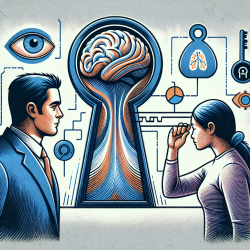Unlocking the Power of Visual Motion: Lessons from Early-Deaf Adults
In the realm of special education and therapy, understanding the unique capabilities and adaptations of individuals with sensory impairments can lead to transformative educational strategies. The research article "Enhancement of visual biological motion recognition in early-deaf adults: Functional and behavioral correlates" provides profound insights into how early-deaf adults excel in recognizing visual biological motion. This study not only sheds light on the neuroplasticity of the brain but also offers practical implications for practitioners working with individuals who have sensory impairments.
Understanding Cross-Modal Plasticity
The study highlights the concept of cross-modal plasticity, where the brain compensates for sensory loss by enhancing other senses. In early-deaf adults, the auditory cortex, typically responsible for processing sound, is repurposed to enhance visual motion recognition. This adaptation results in a functional advantage, allowing deaf individuals to detect communicative gestures more effectively than their hearing counterparts.
Implications for Practitioners
For practitioners, these findings underscore the importance of leveraging the visual strengths of deaf individuals in therapeutic and educational settings. Here are some strategies to consider:
- Incorporate Visual Learning Tools: Utilize visual aids and motion-based activities to engage and teach deaf individuals, capitalizing on their enhanced visual processing abilities.
- Emphasize Gesture-Based Communication: Encourage the use of sign language and gestures in therapy sessions to facilitate communication and learning, aligning with the natural strengths of the individual.
- Tailor Educational Content: Design educational materials that are visually rich and interactive, allowing deaf students to process information through their heightened visual perception.
Encouraging Further Research
While the study provides valuable insights, it also opens avenues for further research. Practitioners are encouraged to explore the following areas:
- Individual Variability: Investigate how individual differences, such as the age of onset of deafness and the use of sign language, influence visual motion recognition and neuroplasticity.
- Longitudinal Studies: Conduct long-term studies to observe how visual motion recognition abilities evolve over time in deaf individuals and how these changes impact learning and communication.
- Cross-Disciplinary Approaches: Collaborate with neuroscientists and educators to develop comprehensive strategies that integrate findings from neuroscience into educational practices.
Conclusion
The research on visual biological motion recognition in early-deaf adults offers a powerful example of the brain's adaptability and the potential for targeted educational strategies. By embracing these insights, practitioners can enhance their approaches, providing more effective support to individuals with sensory impairments.
To read the original research paper, please follow this link: Enhancement of visual biological motion recognition in early-deaf adults: Functional and behavioral correlates.










